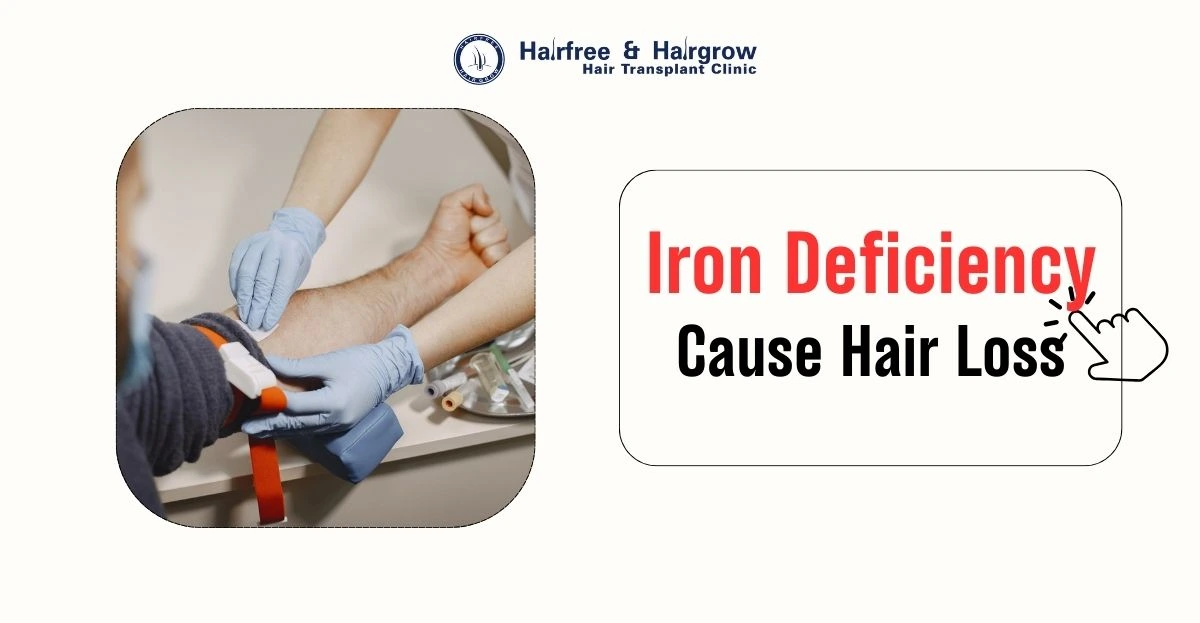Iron deficiency is a common nutritional problem that affects many health issues, including hair growth. Low iron levels could contribute to thinning or excessive hair loss.
But how exactly does iron affect hair health, and can restoring iron levels help reduce hair loss? Let’s explore the connection between iron deficiency and hair loss.
Table of Contents
The Role of Iron in the Body
Iron is essential for various bodily functions. One of its primary roles is producing hemoglobin, a protein in red blood cells that transports oxygen to tissues, including hair follicles. Hair growth relies on a steady oxygen supply, and when iron levels are low, hair follicles may not receive enough nutrients to support healthy growth.
Beyond oxygen transport, iron also contributes to immune function, enzyme production, and energy metabolism. These processes contribute to overall hair health, ensuring that hair remains strong, thick, and resilient.

How Iron Deficiency Affects Your Hair Growth
When the body lacks sufficient iron, it prioritizes vital organs like the heart and brain over non-essential functions like hair growth. This can lead to telogen effluvium, a condition in which more hair than usual enters the resting phase and sheds prematurely.
Without enough iron, hair follicles receive less oxygen and nutrients, making hair weaker and more prone to breakage. Over time, this can lead to noticeable thinning, especially on the top of the scalp or along the hair parting.
Read Also: The Hair Growth Cycle & What Happens Every 7 Years to Your Hair?
Signs That Iron Deficiency May Be Causing Hair Loss
Iron deficiency doesn’t just affect hair it also impacts overall health. Some symptoms to watch for include:
- Excessive hair shedding, especially during washing or brushing
- Hair becomes brittle, dry, and more prone to breakage
- Increased fatigue and lack of energy
- Dizziness or lightheadedness
- Pale skin and cold hands or feet due to poor circulation
If you’re experiencing multiple symptoms alongside hair loss, it’s a good idea to get your iron levels checked.
Who Is at Risk of Iron Deficiency?
Some people are more likely to develop iron deficiency due to lifestyle, diet, or health conditions. These include:
- Women with heavy menstrual cycles, as they lose more blood each month
- Pregnant women, since their bodies require more iron to support fetal development
- Vegetarians and vegans who may not consume enough iron-rich foods
- Individuals with digestive disorders like celiac disease or Crohn’s, which can impair iron absorption
- Athletes who experience increased iron loss through sweat and physical exertion
Read Also: Which Vitamin Deficiency Causes Hair Loss?
Diagnosing Iron Deficiency
If you suspect iron deficiency is causing hair loss, a doctor may recommend a blood test. The most common tests include:
- Complete Blood Count (CBC): Measures hemoglobin levels and overall red blood cell health.
- Serum Ferritin Test: Evaluates stored iron levels, as ferritin is an indicator of the body’s iron reserves.
- Iron and Total Iron-Binding Capacity (TIBC) Test: Assesses how well iron is being transported in the body.
Low ferritin levels are particularly associated with hair shedding, even if overall hemoglobin levels appear normal.
How to Restore Iron Levels and Promote Hair Regrowth
1. Eat an Iron-Rich Diet
One of the best ways to increase iron levels is through food. Iron-rich sources include:
- Animal-based (heme iron): Red meat, liver, chicken, turkey, and fish
- Plant-based (non-heme iron): Spinach, lentils, beans, tofu, quinoa, and fortified cereals
- Vitamin C sources: Bell peppers, oranges, and strawberries, which help improve iron absorption.
2. Consider Iron Supplements
If dietary changes aren’t enough, supplements may be necessary. Doctors often recommend ferrous sulfate or other iron supplements, but it’s important to take them as directed. To maximize absorption:
- Avoid consuming iron with calcium-rich foods, dairy, or caffeine, as these can hinder absorption.
- Take iron supplements with a source of vitamin C, like a glass of orange juice.
3. Improve Overall Hair Care
While correcting iron deficiency is key, good hair care habits can also support regrowth.
- Use gentle shampoos and avoid excessive heat styling.
- Massage the scalp to boost circulation and encourage hair growth.
- Manage stress levels, as chronic stress can worsen hair loss.
How Bangladeshi People Manage Iron Deficiency Problem
Iron deficiency is a common health concern in Bangladesh, especially among women and children. Several factors, including dietary habits, economic conditions, and limited access to nutrient-rich foods, contribute to this.
However, people in Bangladesh have found various ways to manage and prevent iron deficiency-related hair loss.
1. Dietary Practices
Bangladeshi cuisine includes several iron-rich foods that help maintain proper iron levels. Common sources include:
- Fish and Meat: Hilsa (ilish), beef liver, and small fish varieties like mola and puti are excellent sources of iron.
- Green Leafy Vegetables: Spinach (pui shak), water spinach (kolmi shak), and red amaranth (lal shak) are widely consumed for their high iron content.
- Legumes and Pulses: Lentils (dal), chickpeas (boot), and black gram (mashkalai dal) are staple sources of plant-based iron.
- Jaggery (Gur): Often used in traditional sweets, jaggery is a natural source of iron.
Many people consume these foods with vitamin C-rich ingredients like tomatoes, green chilies, and citrus fruits to enhance iron absorption.
2. Herbal Remedies
Some traditional herbal treatments are popular in Bangladesh for promoting hair health and preventing hair loss. These include:
- Amla (Indian Gooseberry): Rich in vitamin C, amla is used both in diet and as a hair treatment to strengthen hair.
- Henna and Fenugreek Seeds: These natural remedies are commonly applied to hair to improve scalp health.
- Mustard Oil Massages: Many people use mustard oil infused with garlic or onion to boost scalp circulation and strengthen hair follicles.
3. Government and Health Initiatives
The Bangladeshi government and health organizations have taken steps to combat iron deficiency through
- Iron Fortification Programs: Fortifying staple foods like rice and flour with iron to help address widespread deficiencies.
- Iron and Folic Acid Supplementation: Providing free supplements to pregnant women and children in rural areas.
- Awareness Campaigns: Educating people on the importance of iron-rich diets and proper nutrition.
4. Lifestyle Adjustments
To maintain healthy hair and prevent excessive shedding, many people in Bangladesh adopt simple lifestyle changes such as:
- Avoiding excessive use of chemical-based hair treatments and harsh shampoos.
- Use natural hair masks made from yogurt, eggs, and honey.
- Managing stress through yoga and meditation, which helps prevent stress-related hair loss.
How Long Does It Take for Hair to Grow Back?
Hair regrowth varies depending on the severity of iron deficiency. Once iron levels are restored:
- Shedding should decrease within 2-3 months.
- Visible hair regrowth may take 3-6 months.
- Full hair restoration can take up to a year, depending on person to person.
When You to Need See a Doctor
If hair loss continues despite improving iron levels, it’s worth consulting a doctor. Other conditions, such as androgenetic alopecia (genetic hair loss), thyroid disorders, autoimmune diseases, or hormonal imbalances, could be contributing factors.
Conclusion
Iron deficiency is a potential cause of hair loss, but the good news is that it’s often reversible. By improving iron intake through diet or supplements and maintaining good hair care practices, many people see noticeable improvements in hair thickness and strength. If you suspect low iron levels are affecting your hair, getting tested and addressing the deficiency can help restore healthy growth.

Written By
Medical Officer & Hair Transplant Surgeon
Dr. Nazmin Sultana Nipa is a distinguished hair transplant doctor in Bangladesh, known for her advanced skills in hair restoration. As a Medical Officer and Hair Transplant Surgeon, Dr. Nipa combines her extensive experience in the field with a focus on transparency and patient-centered care.
Disclaimer
We’ve made all possible efforts to ensure that the information provided here is accurate, up-to-date and complete, however, it should not be treated as a substitute for professional medical advice, diagnosis or treatment. See Detailed Disclaimers Here.




